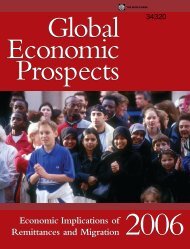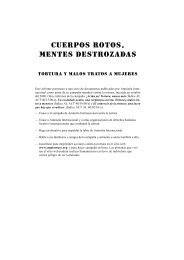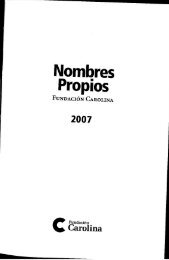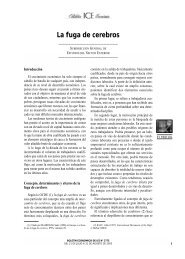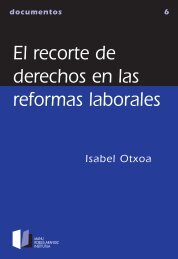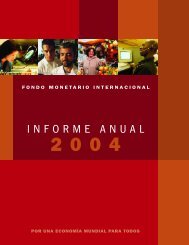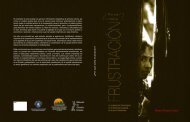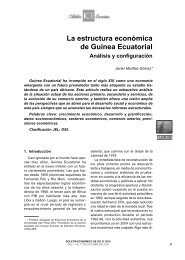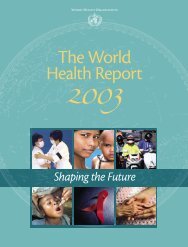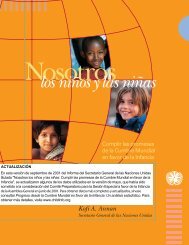Educación para todos: el imperativo de la calidad; Informe ... - eFaber
Educación para todos: el imperativo de la calidad; Informe ... - eFaber
Educación para todos: el imperativo de la calidad; Informe ... - eFaber
- No tags were found...
Create successful ePaper yourself
Turn your PDF publications into a flip-book with our unique Google optimized e-Paper software.
REFERENCIAS / 443—. 2004. Knowledge infrastructures for quality improvement. Documento <strong>de</strong> referencia <strong>para</strong> <strong>el</strong> <strong>Informe</strong> <strong>de</strong>Seguimiento <strong>de</strong> <strong>la</strong> EPT en <strong>el</strong> Mundo 2005.Horsley, M. 2004. An expert teacher’s use of textbooks in the c<strong>la</strong>ssroom. Sydney, Universidad <strong>de</strong> Sydney.(http://alex.edfac.usyd.edu.au/Year1/cases/Case % 2014/Expert_teacher’s_use_of_te. html).Hoxby, C. 2000. “The effects of c<strong>la</strong>ss size on stu<strong>de</strong>nt achievement: new evi<strong>de</strong>nce from popu<strong>la</strong>tion variation”.Quarterly Journal of Economics, Vol. 115, Nº 4, págs. 1.239-1.285.Hunt, J. 1961. Int<strong>el</strong>ligence and experience. Nueva York, Ronald Press.IHSD. 2003. Sector wi<strong>de</strong> approaches in education. Londres, Institute for Health Sector Dev<strong>el</strong>opment (IHSD).Illich, I. 1975. La sociedad <strong>de</strong>sesco<strong>la</strong>rizada. Barc<strong>el</strong>ona, Barral editores, S.A..INEP. 2002. Geografia da educação brasileira: statistical handbook. Brasilia, Instituto Nacional <strong>de</strong> Estudios eInvestigaciones Educativas Anísio Teixeira (INEP).Instituto <strong>de</strong> Estadística <strong>de</strong> <strong>la</strong> UNESCO (IEU). 2001. Education for All Indicators Expert Group Meeting – Report onthe meeting and proposals for the future <strong>de</strong>v<strong>el</strong>opment of EFA indicators [Reunión d<strong>el</strong> grupo <strong>de</strong> expertos sobreindicadores <strong>de</strong> <strong>la</strong> EPT – <strong>Informe</strong> <strong>de</strong> <strong>la</strong> reunión y propuestas <strong>de</strong> futuros indicadores <strong>de</strong> <strong>la</strong> EPT]. Montreal/París,Instituto <strong>de</strong> Estadística <strong>de</strong> <strong>la</strong> UNESCO (IEU).—. 2004a. Compendio Mundial <strong>de</strong> <strong>la</strong> Educación 2004. Montreal/París, Instituto <strong>de</strong> Estadística <strong>de</strong> <strong>la</strong> UNESCO (IEU).—. 2004b. The primary completion rate: feasibility as an international indicator. Montreal/París, Instituto <strong>de</strong>Estadística <strong>de</strong> <strong>la</strong> UNESCO (IEU) (en prensa).Instituto <strong>de</strong> Estadística <strong>de</strong> <strong>la</strong> UNESCO (IEU)/OCDE. 2003. Financing education: investments and returns.Montréal/París, IEU/OCDE.Instituto Nacional <strong>de</strong> Educación <strong>de</strong> Sri Lanka. 2002. Performance of gra<strong>de</strong> 3 stu<strong>de</strong>nts in literacy and numeracy(after 3 years of implementation of education reforms). Maharagama, Instituto Nacional <strong>de</strong> Educación.IRFOL. 2004. Distance learning and improving the quality of education. Documento <strong>de</strong> referencia <strong>para</strong> <strong>el</strong> <strong>Informe</strong><strong>de</strong> Seguimiento <strong>de</strong> <strong>la</strong> EPT en <strong>el</strong> Mundo 2005. Cambridge, Fundación Internacional <strong>para</strong> <strong>la</strong> Investigación enAprendizaje Abierto (IRFOL).IUE. 2004. Quality adult learning. Documento <strong>de</strong> referencia <strong>para</strong> <strong>el</strong> <strong>Informe</strong> <strong>de</strong> Seguimiento <strong>de</strong> <strong>la</strong> EPT en <strong>el</strong> Mundo2005. Hamburgo, Instituto <strong>de</strong> <strong>la</strong> UNESCO <strong>para</strong> <strong>la</strong> Educación.Jaramillo, A.; y Mingat, A. 2003. Early childhood care and education in sub-Saharan Africa: what would it take tomeet the Millennium Dev<strong>el</strong>opment Goals?. Washington, D. C., Banco Mundial.Jarousse, J. P.; Mingat, A.; y Richard, M. 1992. “La sco<strong>la</strong>risation matern<strong>el</strong>le à 2 ans: effets pédagogiques y sociaux”.Éducation y formations, Nº 31, págs. 3-9.Jarvis, P. 1983. Adult and continuing education: theory and practice. Londres, Croom H<strong>el</strong>m.Jencks, C.; Bartlett, S.; Corcoran, M.; Crouse, J.; Eaglesfi<strong>el</strong>d, D.; Jackson, G.; y otros 1979. Who gets ahead?The <strong>de</strong>terminants of success in America. Nueva York, Basic Books.Jepsen, C.; y Rivkin, S. 2002. What is the tra<strong>de</strong>off between smaller c<strong>la</strong>sses and teacher quality? Cambridge(Massachusetts, EE.UU.), Oficina Nacional <strong>de</strong> Investigación Económica (NBER) (Documento <strong>de</strong> trabajo d<strong>el</strong>a NBER, Nº 9205).Jessee, C.; Mchazime, H.; Dowd, A. J.; Winicki, F; Harris, A.; y Schubert, J. 2003. Exploring factors that influenceteaching and learning: summary findings from the IEQ/Ma<strong>la</strong>wi longitudinal study 1999-2002. Washington, D. C.,Proyecto <strong>de</strong> Mejora <strong>de</strong> <strong>la</strong> Calidad <strong>de</strong> <strong>la</strong> Educación d<strong>el</strong> Organismo <strong>de</strong> los Estados Unidos <strong>para</strong> <strong>el</strong> DesarrolloInternacional (USAID) (Documento USAID Nº PN-ACU-230) (www.ieq.org/pdf/Exploration_into_Findings. pdf).Jiménez, E.; y Sawada, Y. 1998. Do community-managed schools work? An evaluation of El Salvador’s EDUCOprogram. Washington, D. C., Banco Mundial, Grupo <strong>de</strong> investigación sobre <strong>de</strong>sarollo económico. (Documento<strong>de</strong> trabajo, Nº 8, Serie sobre <strong>la</strong> evaluación d<strong>el</strong> impacto <strong>de</strong> <strong>la</strong>s reformas educativas).Jolliffe, D. 1998. “Skills, schooling, and household income in Ghana”. World Bank Economic Review, Vol. 12, págs.81-104.Jonassen, D. H. 1992. “Evaluating constructivist learning” en T. M. Duffy y D. H. Jonassen (compi<strong>la</strong>dores),Constructivism and the technology of instruction: a conversation. Hillsdale (Nueva Jersey), Lawrence ErlbaumAssociates, págs. 138-148.Ju<strong>el</strong>, C. 1991. “Beginning reading” en R. Barr, M. L. Kamil, P. B. Mosenthal y P. D. Pearson (compi<strong>la</strong>dores),Handbook of reading research. Vol. 2. Nueva York, Longman, Capítulo 27.Kagitçbasi, Ç. 1996. Family and human <strong>de</strong>v<strong>el</strong>opment across cultures: a view from the other si<strong>de</strong>. Hillsdale(Nueva Jersey), Lawrence Erlbaum Associates.





